ROAD TRIP
Posted February 11 ’10Felix Duarte and I just got back from a long road trip. Felix is my character from POINT DUME. Even though I killed him in the book he won’t die off in my heart. He continues to haunt me and so I threw him in the car and went looking for his story. Felix likes to listen to Ozomatli—a popular Mexican band—and it turns out I like them too. As I drove, I struggled to understand the Spanish lyrics and tried to sing along—my favorite song is “Violeta” in which they ask, “Y tu abuela, que dice?” (And your grandmother, what does she say?) Felix thinks my attempts at Spanish are hilarious. A beautiful day, we were having a great old time driving down the freeway, marveling at the strangeness of the Salton Sea and enjoying the beautiful desert. It was all fun and games until we arrived at our first stop.
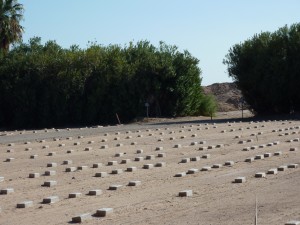
Evergreen Cemetery, El Centro, CA
Evergreen Cemetery is in El Centro, California. It is a nice little graveyard. There are trees and well tended grave sites where family members congregate. But if you drive all the way to the back of the property, you will come to the county lot where they dispose of all the John and Jane Does—or as some call them, Juan and Juana Does. I knew that over 500 people had drowned trying to swim across the nearby All American Canal, which separates Mexico from California in the area east of Calexico. I knew that many of the migrants were not identified, their families never notified, and that they were buried under concrete markers, acknowledged only by a number.
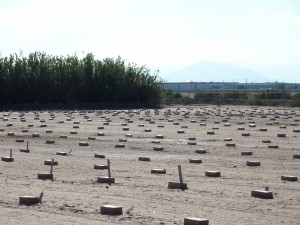
Unidentified Migrant Graves
But I was not prepared to see them all together in one place, row after row of bodies—hundreds of anonymous dead. It literally brought me to my knees. I’ve been told that the Evergreen county lot is full to capacity and I believe it. Now officials are scrambling to find a new site because the number of dead bodies continues to grow. There are “No Trespassing” signs all around the migrant area of the cemetery but I ignored them and stayed for quite awhile, trying to imagine the lives of these people and the loved ones they left behind. Then I got back in the car and drove to the All American Canal which is basically a huge irrigation ditch that runs along our border.
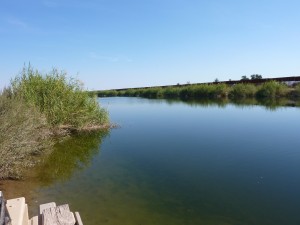
All American Canal near Calexico, CA
In some areas the canal seems like a peaceful, calm river. There are birds and fish. I could imagine jumping in for a swim on a hot day. If not for the border fence in the background it would be an ideal place for a picnic. But the water is very cold and deep with a strong current running just below the surface. The All American Canal functions in our country much like the moats surrounding medieval castles. It is the first line of defense against invasion—sound the horns, pull up the drawbridge, drown the enemy. All that’s missing are the serpents and crocodiles.
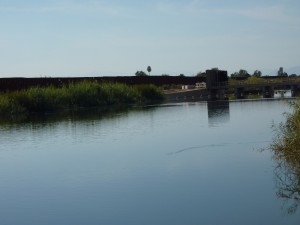
Catch Drop All American Canal
Along the canal, there are a series of drops and it is here that the bodies are most often found. The dead tend to get caught up in the hydraulics. They have to be plucked out of the water by a special crane, built specifically for the purpose. There are no buoys, no safety nets or ladders to help save those in trouble. If you’re not a strong swimmer, chances are you’re not going to make it. You will drown. This is our U.S. border. These people are dying on our land. Our government knows. In fact, our government had the special crane built to pick out the bodies, and our government pays to bury these poor people when they die. But our government does nothing to stop people from jumping in.
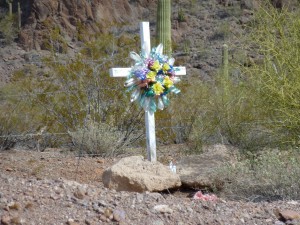
I had planned to spend the night in El Centro but after seeing the graveyard and the canal, I needed to get out of there so I drove the extra hour to Yuma, Arizona. Along the way I saw Border Patrol zooming around everywhere. I saw several of the trucks dragging tires along the back dirt roads. This is a technique used for tracking. They smooth the roads and then later are able to read the dirt for signs of migrant footprints moving through the desert. Typically they’ll have five tires chained together and attached to the back bumper of the Border Patrol truck. They drag the roads all along the border and throughout the desert and have a high success rate of catching migrants and deporting them back to Mexico. But the arrests are a mere drop in the bucket in terms of numbers because hundreds come across every night, drawn by the promise of work and a better life for their families. The tragedy is that many of them get lost forever in that unforgiving desert and are baked alive by that brutal sun. During my time on the road, I saw hundreds of crosses marking the spots where these poor souls had fallen.
I went to bed early that first night, exhausted by what I’d seen. Next day would be the Tohono O’odham Indian Reservation.




